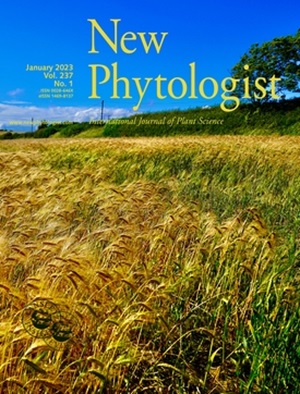Spray-induced gene silencing of three G-protein signaling genes from the arbuscular mycorrhizal fungus Rhizophagus irregularis inhibits spore germination and hyphopodium formation
IF 8.3
1区 生物学
Q1 PLANT SCIENCES
引用次数: 0
Abstract
- About 70% of land plants form symbioses with arbuscular mycorrhizal (AM) fungi. Some plant genes important for accommodating AM fungi within roots have been characterized, but AM fungal genes involved in asymbiotic growth and hyphopodium formation remain elusive due to a lack of methods for genetic manipulation.
- Here, we introduce an innovative gene silencing technology based on spraying double-stranded RNA (dsRNA) to characterize the functions of three genes encoding G-protein signaling proteins, including the regulator of G-protein signaling RiRgs3, the Gα subunit RiGpa3, and the Gβ subunit RiGpb1 from the AM fungus Rhizophagus irregularis at the asymbiotic and initial symbiotic stages.
- RiRgs3, RiGpa3, and RiGpb1 expression is induced in the early stages of AM symbiosis. Using spray-induced gene silencing (SIGS), we discovered that R. irregularis can take up dsRNA. Moreover, SIGS of RiRgs3, RiGpa3, or RiGpb1 led to defects in spore germination and hyphopodium formation.
- In conclusion, our results reveal that SIGS is a suitable technique for the analysis of gene function in AM fungi and that G-protein signaling is required for spore germination and hyphopodium formation.
喷雾诱导的3个g蛋白信号基因沉默抑制了丛枝菌根真菌Rhizophagus irregularis孢子萌发和菌丝形成
大约70%的陆地植物与丛枝菌根(AM)真菌形成共生关系。一些在根内调节AM真菌的重要植物基因已经被表征,但由于缺乏遗传操作方法,参与非共生生长和菌丝形成的AM真菌基因仍然难以捉摸。本研究采用基于喷雾双链RNA (dsRNA)的基因沉默技术,对AM真菌不规则根噬菌(Rhizophagus irregularis)的g蛋白信号调控基因riggs3、Gα亚基RiGpa3和Gβ亚基RiGpb1在非共生和共生初始阶段的功能进行了研究。在AM共生的早期阶段,riggs3、RiGpa3和RiGpb1的表达被诱导。利用喷雾诱导的基因沉默(SIGS)技术,我们发现不规则田鼠可以吸收dsRNA。此外,rigs3、RiGpa3或RiGpb1的SIGS导致孢子萌发和菌丝形成缺陷。综上所述,我们的研究结果表明,SIGS是一种适合分析AM真菌基因功能的技术,g蛋白信号是孢子萌发和菌丝形成所必需的。
本文章由计算机程序翻译,如有差异,请以英文原文为准。
求助全文
约1分钟内获得全文
求助全文
来源期刊

New Phytologist
生物-植物科学
自引率
5.30%
发文量
728
期刊介绍:
New Phytologist is an international electronic journal published 24 times a year. It is owned by the New Phytologist Foundation, a non-profit-making charitable organization dedicated to promoting plant science. The journal publishes excellent, novel, rigorous, and timely research and scholarship in plant science and its applications. The articles cover topics in five sections: Physiology & Development, Environment, Interaction, Evolution, and Transformative Plant Biotechnology. These sections encompass intracellular processes, global environmental change, and encourage cross-disciplinary approaches. The journal recognizes the use of techniques from molecular and cell biology, functional genomics, modeling, and system-based approaches in plant science. Abstracting and Indexing Information for New Phytologist includes Academic Search, AgBiotech News & Information, Agroforestry Abstracts, Biochemistry & Biophysics Citation Index, Botanical Pesticides, CAB Abstracts®, Environment Index, Global Health, and Plant Breeding Abstracts, and others.
 求助内容:
求助内容: 应助结果提醒方式:
应助结果提醒方式:


